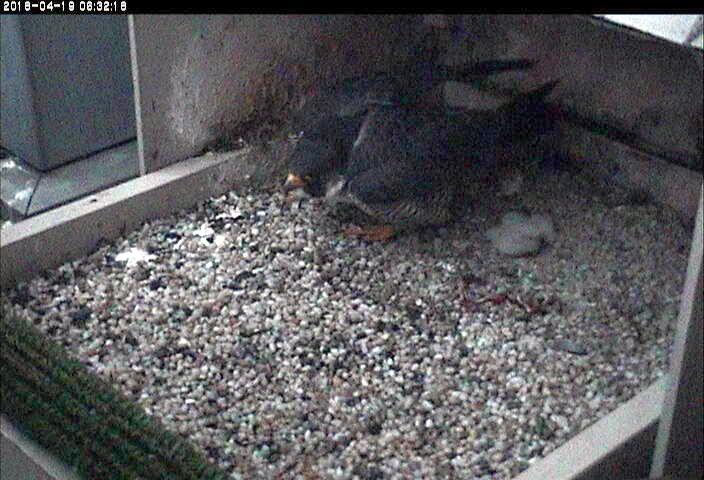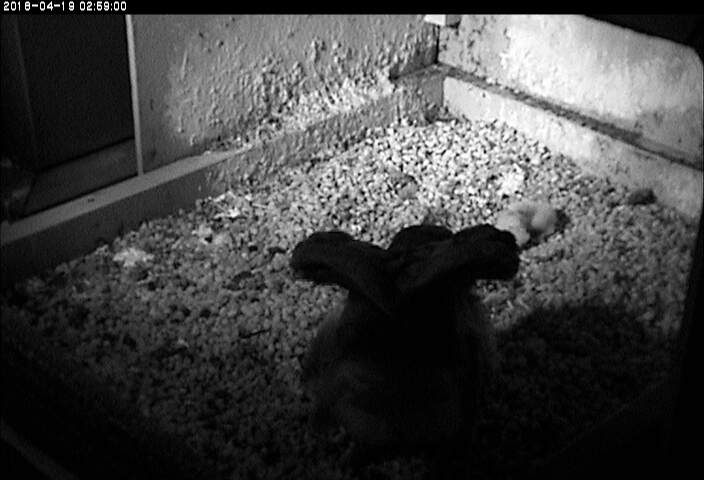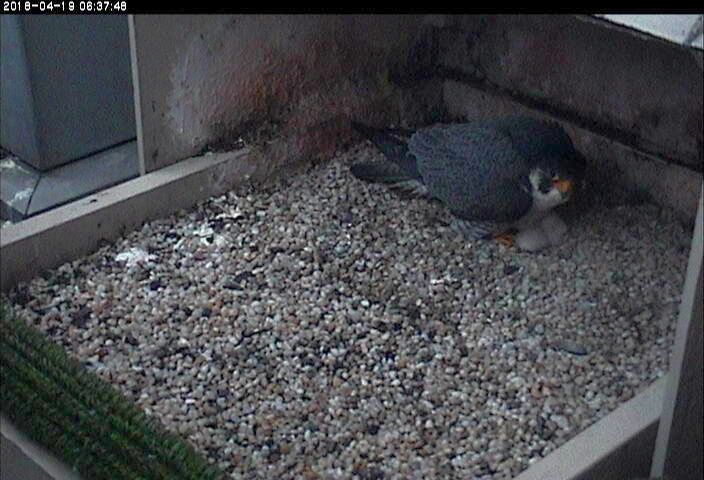
Thursday April 19, 2018 at 7:30am.
Yes, there’s an exclamation point in the title! The suspense is over. Out of four hatched eggs, Hope killed two chicks and spared two. (Click here for Hope’s history of killing her young.)
The 4th egg:
Last night at 11:15pm Hope pulled an eggshell from the nest beneath her. We knew the 4th egg had hatched but no one could see if the chick was OK. Hope gave us a hint last night when she stepped aside at 3am and revealed two chicks (below).

We saw them clearly when Terzo brought food at dawn. At top, Hope leaves to get the food. And here Terzo arrives to brood them while she’s gone. (Typically the mother peregrine eats a little, then brings the rest back to feed the babies.)

Every year after hatching is over, Hope becomes a good mother. She fledged 1 youngster in 2016 and 3 in 2017.
So the coast is clear. Whew!
A word about naming the chicks:
At Pittsburgh’s on-camera sites we use a naming scheme similar to that used at bald eagle nests: a letter for the location plus the hatch number. The Cathedral of Learning is “C” and last year’s chicks were C6 to C8 so this year’s chicks are C9 and C10.
(photo from the National Aviary falconcam at Univ. of Pittsburgh)
So glad to hear the last two have a chance. Thanks for keeping us posted, Kate.
Kate…..is there a reason you don’t assign numbers to the ones that actually hatched but didn’t make it (were eaten). After all, they did hatch, but didn’t make it for whatever reason……Just curious
Sharon, Last year I was still counting the dead ones, but now that Hope’s pattern is clear I have given up counting those that were eaten within minutes of hatching. There are plenty of records that they existed, even without names.
Thanks Kate for the steady stream of info on your blog, especially but not only the peregrines. I hope the rest of the summer is only dramatic in good ways!
Thanks, Kate! The hatching drama is over. What a relief. I appreciate your updates and especially your willingness to watch this play out for us, knowing how unpleasant Hope’s behavior is. Thank you!
Whew…Exhale.
Wonderful news!
Great news! Thanks for pictures of the little ones. I haven’t been able to see them completely yet, but I thought I saw two squirming fuzz balls!
Now comes the fun time watching them grow into beautiful birds. So glad drama is over and 2 have hatched successfully. So many nests across the country with babies. Eagles, ospreys, and our peregrines. Fun time for bird lovers.
Feeding at 9:45 am
Thanks for the update, DebK!
Another feeding at 10:22 am. Looks like things are going good!!
Wonderful news , best wishes for their future.
With baited breath I checked into see outcome. Sooo happy!!!! 2 babies!!! Will never understand Hope’s behavior but hopefully we will see two chicks grow strong and fledge.
Kate, I know there is no known reason for Hope’s behavior, but I wanted to throw this out there.
Could her behavior possibly be based on her own hatching experience? Could Hope have struggled trying to break out of the egg? Would that be why she tries to help the hatching process even though this goes against typical bird behavior? I don’t think she recognizes the eyas as a living being until it is free of the egg and on its own waiting for feeding.
Joyce, we don’t know … But here’s a twist on your last point: “Perhaps she thinks the eyas is prey (not a peregrine) until the point at which it is free of the egg and on its own waiting for feeding.”
And if so, why don’t other peregrines think that?
Hope’s behavior has totally turned me off from watching the CoL nestcam. I can’t get any enjoyment from watching her raise the chicks that are left knowing what she did to the other ones, it just makes me sad. I hope that eventually a normal bird takes up residence there.
I understand how you feel Mary Ann Pike. Following abnormal behavior is difficult for me also. Once I observed her picking up the partially hatching chicks, I had to turn off the cam because I knew what was going to happen after watching for the past three years. I have not given up on following this cam however. Hope appears, to me, to be a very good mother if the chicks make it through hatching. More of me feels sorry for her disturbing behavior however than blaming her for being horrible. There is obviously a reason she does this that we will probably never know.
Good morning, Kate!
So glad at least two little ones are alive and ready to grow up.
As just found this, thought it’s interesting although it doesn’t explain anything about that killing behavior, just another example of the mysterious pattern which leads a peregrine mother to kill her own offspring. Probably they became too week in order to survive and she couldn’t help them anymore.. just speculation.
http://www.arcticraptors.ca/pdf_docs/Arctic66-2-226.pdf
Good to hear from you, Giovanna. I wish I could say your theory about “became too weak to survive” was true but their mother yanked them out of their eggs as they were hatching and killed & ate them immediately. They had no chance to weaken.